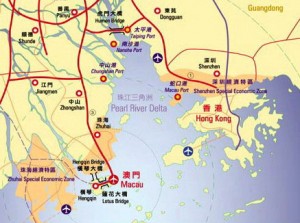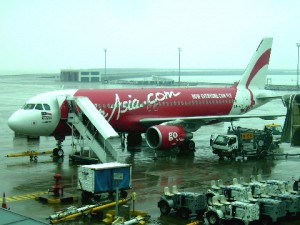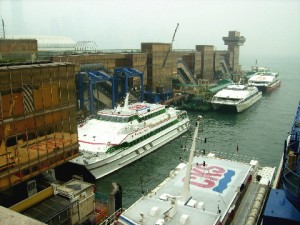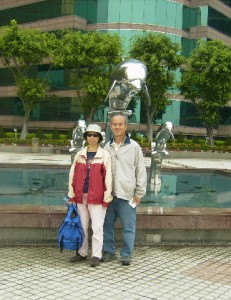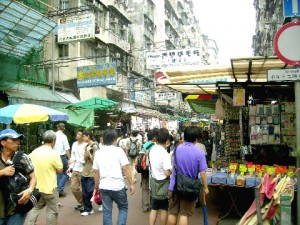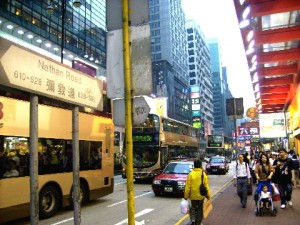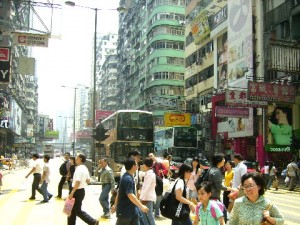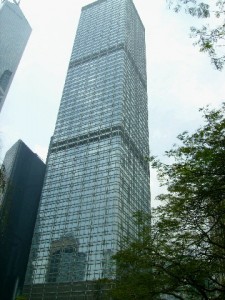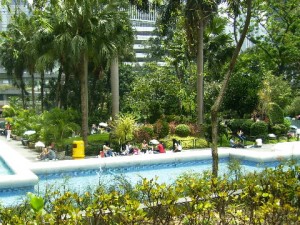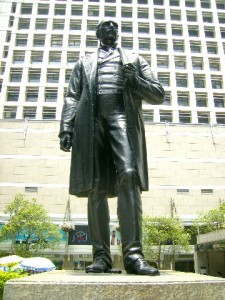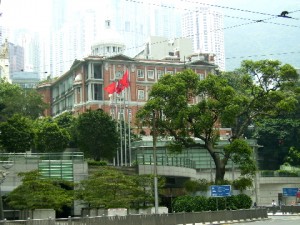Hong Kong Travel (Part I)
Hong Kong is a well-known territory in the world. Located in the south-eastern part of China, it consists of Kowloon, the New Territories, Hong Kong Island, Lantau Island and over 260 small islands in the South China Sea. It has a total area of 1,104 sq. km. and a population of about 7 millions: 90 % of them is Chinese. Most of them are live in Kowloon and the northern part of Hong Kong Island. Hong Kong Island is considered as the most densely-populated island in the world. “Hong Kong” in Chinese means “Fragrant Harbour” as it was once a busy port where fragrant wood products and incense were actively traded. It is separated by a narrow stretch of water known as Victoria Harbour from Kowloon, but it is now connected by three underwater tunnels, viz. Cross-Harbour Crossing, Eastern Harbour Crossing and Western Harbour Crossing.
Historical Facts on Hong Kong: In 1841, Great Britain seized Hong Kong Island from China. A year
later, China ceded Hong Kong Island to Great Britain under the Treaty of Nanking. In 1860 China ceded Kowloon and Stonecutter to the latter again. In 1898, China granted 99-year lease on New Territories, Lantau Island and other islands to Great Britain.
In 1997, Great Britain returned Hong Kong to China, after ruling it for over 150 years. Since 1997, Hong Kong has become a China’s Special Administrative Region (SAR), operating under the “one country, two systems” principle. It means that it enjoys a high degree of autonomy in all affairs except foreign and defence for at least 50 years.
A Vibrant City Hong Kong is a vibrant city and a well-known financial and banking centre in the world. Besides, it is a famous tourists’ destination which offers lots of attractions ranging from historical colonial buildings, places of worship and lush green scenery to restaurants serving delicious and diverse local and
international cuisine, shopping malls, unique modern architectural sky-scrapers and theme parks. For these reasons, my wife and I decided to visit the city in 2007 for three days (from April 30 to May 2, 2007).
Air Asia (Malaysia) often offers cheap airfares to many destinations in Asia. As Hong Kong was not in its list of destinations, we booked the return ticket for a flight from Kuala Lumpur to Macau. Hong Kong is 60 km north-east of Macau.
Hong Kong Itinerary Below is the itinerary of our memorable three-day tour in Hong Kong.
1. Travel to Hong Kong / Tsim Sha Tsui / Kowloon Park
2. Urban Areas of Kowloon / Nathan Road
3. Avenue of Stars / A Symphony of Lights
4. Joy Guest House / Dragon Hostel / Victoria Harbour Tunnels
5. Central / Chater Garden / Legislative Council Building
6. Legislative Council Building / Sir Thomas Statue / A Street Tram
7. Ocean Park / Ocean Park Tower / Ocean Theatre
8. SkyFair at Ocean Park
9. Victoria Peak / Peak Tower / Wax Museum / Peak Tram
10. Skyrail / Lantau Island / Ngong Ping Village
11. Tian Tan Garden / Giant Buddha
12. Po Lin Buddhist Monastery / Wisdom Path / Tsing Ma Bridge
13. Convention and Exhibition Centre / Golden Bauhinia Square
14. Star Ferry / Clock Tower / Museums
Day 1: 30 April 2007
Travel To Hong Kong On the first day of our journey to Hong Kong, we left our homeland, Malaysia, by an Air Asia plane for Macau. On arrival at Macau, we took a ferry to Hong Kong which is 60 km. away. The
70-minute ferry journey was smooth except for a few minutes of rough ride on the choppy sea near our destination. {We took the budget Air Asia plane to Macau because Hong Kong was not in its list of destinations then.}
Tsim Sha Tsui At 1.10 p.m., we reached China Ferry Terminal at Tsim Sha Tsui, Kowloon. From the terminal, we walked through Harbour City (a megamall of four levels of shops, services and restaurants, and a departmental store), crossed a pedestrian bridge over Canton Road, walked through Kowloon Park and finally to Tsim Sha Shui MTR Station.
Mass Transit Railway (MTR) Mass Transit Railway (MTR) is an underground system that is quite extensive in Hong Kong. It is a fast, cheap and convenient way to move around in Hong Kong.
On the way to the MTR station, we stopped for a few minutes in a garden on the rooftop of Harbour City to admire the beautiful dolphin sculptures. These animals were named the official mascot of Hong Kong’s 1997 handover from Great Britain to China. There are big trees in the garden and we wonder how they are able to survive on the roof-top.
Kowloon Park We also stopped in the shady and beautiful Kowloon Park to watch some waterfowls in a pond, like swans, ducks and flamingos. Then we sat in a shady area to rest our tired legs.
Octopus Card On arrival at Tsim Sha Tsui MTR Station, we bought an
electronic fare card known as Octopus Card. We bought it as it was convenient to pay for public transport as well as bills at restaurants and stores.
Joy Guest House in Sham Shui Po Then we left Tsim Sha Tsui MTR station by train for Sham Shui Po where we checked in at a small hostel known as Joy Guest House in a high-rise building in Yee Kuk Street. It is run by a young enterprising couple, Buno and Pansy. After resting for an hour, we left the hostel and started our tour in some urban areas in Kowloon.
Urban Areas of Kowloon: In Kowloon we visited three urban areas,
viz. Sham Shui Po, Mongkok and Tsim Sha Tsui. After visiting them we found out that they have many things in common. They have, among them, a predominantly Cantonese-speaking population, many old multi-storey residential blocks, street-markets, crowded streets, large signboards with colourful neon lights hanging over the main streets, an MTR station, air-conditioned noodle and chicken rice shops, restaurants, shops and roadside stalls selling the same kinds of products at bargain or wholesale prices, some shopping complexes selling branded goods and heavy traffic in the main streets. These places have frequent influxes of bargain-hunters and food lovers from neighbouring areas and Hong Kong Island.
Among all the urban areas in Kowloon, Tsim Sha Tsui has the most number of attractions. It has historic buildings, skyscrapers, a variety of museums, a cultural centre, a beautiful garden, large shopping and
entertainment centres, a scenic promenade where tourists will be mesmerized by the spectacular views of the city on Hong Kong Island and Victoria Harbour.
Nathan Road There is one important road, Nathan Road, which runs directly from Tsim Sha Tsui in the south to Sham Shui Po in the north. It was originally known as Robinson Road, named after the 5th. Governor of Hong Kong, Sir Hercules Robinson. But in 1909, it was changed to Nathan Road, named after the 13th. Governor, Sir Mathew Nathan, as there was a road on Hong Kong
Island having the same name. Along this long busy road are tall buildings that house shops selling branded goods, restaurants, banks, hotels, etc.
Avenue of Stars In the evening we went to the Tsim Sha Tsui promenade where there is a well-known
place which pays tribute to famous film stars and the people involved in Hong Kong film-making. It is known as “Avenue of Stars” that is similar to the Hollywood’s “Walk of Fame”. It was opened in 2004 and features sculptures, plaques with famous film stars’ names (some with the stars’ handprints) and movie history milestone. At the entrance of the place stands a large bronze sculpture of a Hong Kong Film Award.
At this place, there are some kiosks selling film-related items, taking photos of tourists, selling snacks and drinks, making hand models from wax, etc. and are patronized by many tourists.
A Spectacular Display of Lights: “A Symphony of Lights” Extravaganza
Avenue of Stars is the best spot for looking at the stunning skyline of the Hong Kong City on the other side of Victoria Harbour during the day and night. It is also the best place for watching the city’s “A Symphony of Lights” extravaganza at 8 pm, nightly. This dazzling light and sound presentation of neon lights, laser lights and searchlights on more than 30 skyscrapers on both sides of the Victoria Harbour choreographed to some lively musics mesmerizes the tourists. It is supposed to showcase the vibrancy and charm of Hong Kong as a metropolitan city.
“A Symphony of Lights” earns Hong Kong the Guinness Book of World Records as the “World’s Largest Permanent Light and Sound Show”.
Tourist Cruise Boats While we were at Avenue of Stars watching the “A Symphony of Lights”, we saw some
boats chugging along the Victoria Harbour. They were carrying tourists to watch the spectacular show and see the stunning sight of the brightly-lit skyscrapers. After the 20 minute light show we went back to our hostel in Sham Shui Po.
Day 2: Tuesday 1 May
In the morning of the second day, we checked out from the hostel, Joy Guest House, and walked to a coffee-shop to have our last breakfast in Sham Shui Po. (Most of the food and beverage shops in Hong Kong are air-conditioned.)
Secondhand Goods As we were walking along Yee Kuk Road, we saw some workers busy loading
secondhand electrical goods, such as refrigerators, TV’s, VCD/DVD players, radios, etc., into a blue container. Out of curiosity, I asked a local man about the activity and he told me that those things were meant for export to third world countries. After a hearty breakfast at a coffee-shop in Sham Sui Po, we left for Mongkok.
Dragon Hostel in Mongkok On arrival at Mongkok, we entered another budget hostel, Dragon Hostel, in Argyle Street. As we were too early to check in, we left our luggage with Stanley, the hostel owner, and decided to visit Central on the Hong Kong Island.
Instead of taking a ferry from Kowloon to the island, we took an MTR train from Mongkok to Central. This rail transport is faster as the train goes through a tunnel under the Victoria Harbour water.
Victoria Harbour Tunnels Hong Kong Island is now linked to Kowloon by three tunnels built under the Victoria Harbour water, viz. Cross-Harbour Tunnel (opened in 1972), Eastern Harbour Crossing and Western Harbour Crossing. These tunnels help to reduce travelling time between the financial and commercial cities on both sides of Victoria Harbour.
Central Central, Admiralty and part of Sheung Wan on Hong Kong Island were the early British settlements
when Hong Kong became a British colony in 1842. They were, originally, known as Queenstown but later Victoria City. Nowadays, the name “Victoria” refers to Victoria Harbour and Victoria Peak in Hong Kong. Central has been Hong Kong’s hub of commercial, financial and banking activities since the arrival of the British in 1841.
Central Business District Located in this central business district (CBD) are many multi-national commercial, financial and banking headquarters, five-star hotels, large shopping complexes and shops
selling branded goods. Besides, it has some historical buildings built in the British colonial era, such as Western Market, Government House, Legislative Council Building, Court of Final Appeal, Flagstaff House Museum of Tea Ware, Foreign Correspondents’ Club, Star Ferry Terminal and St. John’s Cathedral.
Skyscrapers Standing in Central, we felt so small in size as we were surrounded by skyscrapers, like
Cheung Kong Center(62 floors), Island Shangrila(57 floors), Bank of China
Tower(70 floors), Standard Chartered Bank Building(45 floors), HSBC Main Building(52 floors), AIG Tower(40 floors), Jardine House(52 floors), Exchange Square(52 floors), Two IFC(88 floors, the tallest building in Central), and many more.
Bank of China Tower Among the skyscrapers in Hong Kong, I find Bank of China Tower the most unusual one. This unique building is easily recognizable in the distance. Built in 1990, it has geometrical lines which are supposed to resemble a bamboo plant symbolizing revitalization and hope. It was designed by a well-known Chinese American architect, Ieoh Ming Pei, who is an MIT and Harvard graduate in architecture. He was born in Canton,
China in 1917. Louvre Pyramid in Paris (1989), Raffles City in Singapore (1985), Rock and Roll Hall of Fame in Cleveland, Ohio and Museum of Islamic Arts in Doha, Qatar are some of his designs.
Chater Garden While walking to a public garden, Chater Garden, we heard a lot of noise. At first, we thought birds were making the noise there. But when we reached the place we were surprised to see many groups of foreign maids having picnic and chattering away. Then I jokingly told my wife that the name of the garden should be changed to “Chatter Garden”.
Foreign Maids in Chater Garden A lot of foreign maids were at the garden because it was a public holiday, Labour Day (1 May 2007). I guess they meet each other on weekends too and Chater Garden is one of their favourite rendezvous. At present there are about 250,000 foreign maids in Hong Kong and most of them are from poor countries, like the Philippines and Indonesia.
Chater Garden is named after an influential Hong Kong businessman, Sir Catchick Paul Chater (1846-1926). It is a medium-sized garden with many shady trees and a pool of water located right in front of Legislative Council Building.
Legislative Council Building Standing in Chater Garden, I saw a majestic, quaint building. It was built in 1912 in neo-classical style with columns and arches along Jackson Road. Originally, it housed the Supreme Court. But in 1985, it was taken over by the Legislative Council which still occupies the building.
On top of the front roof of the building is the Statue of Justice, a
blind-folded lady, Themis, (the Greek Goddess), carrying a sword in one hand and scales in the other. Strangely, this statue has one thing that is different from the Statue of Justice on top of the Old Bailey in London. The latter is not blind-folded.
Statue of Sir Thomas Jackson (1841-1915) It is not easy to find a bronze statue of an important person in Hong Kong. But in Chater Garden, I found one. It was the statue of Sir Thomas Jackson (1841-1915) in front of HSBC Building. HSBC erected it there in honour of his excellent service when he was its Chief Manager from 1870 to 1902.
Court of Final Appeal Building Not far from the Chater Garden is the Court of Final Appeal Building. It was built in neo-classical style in 1917 by the
French Mission. In 1953 it was sold to the Government which successively used it as the Education Department, the Victoria District Court, the Supreme Court and the Information Centre. Now it houses the Court of Final Appeal.
A Street Tram In the afternoon, we left Central and walked to a bus station near Lippo Tower in Admiralty. We intended to visit Ocean Park in the southern part of Hong Kong Island.
On the way to the bus station, we saw an unusual double-decker vehicle moving noisily but slowly on a railway with a cable attached
to its top. It is a street tram that runs along a 13 km railway line on North Hong Kong Island. Since 1904, this classic icon of Hong Kong has been providing an old fashion-style travel experience in the hustling and bustling city. For a ride on a tram, you need to pay a small sum, HKD2.
At the Admiralty bus station, we boarded Citybus no. 629 and soon we were on our way to Ocean Park in the southern part of Hong Kong Island
{To continue reading this travelogue, please go to Hong Kong Travel (Part II)}
Australia Travel / Home / Hong Kong Travel(Part II)
Comments
Tell me what you're thinking...
and oh, if you want a pic to show with your comment, go get a gravatar!

